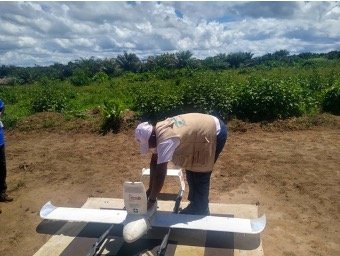 The COVID-19 pandemic has overwhelmed health systems across the globe. In the shadows lies other diseases that can cause more emergencies, such as yellow fever. To face these threats, creative solutions are required to stop the next health crisis. This is exactly what the provincial health officials of Equateur province in the Democratic Republic of Congo (DRC), in collaboration with the Ministry of Health and the Expanded Programme on Immunization (EPI), are doing by leveraging an ongoing drone delivery network established in 2020. It will support a mass yellow fever immunization campaign targeting over 90% of the population, one village at a time.
The COVID-19 pandemic has overwhelmed health systems across the globe. In the shadows lies other diseases that can cause more emergencies, such as yellow fever. To face these threats, creative solutions are required to stop the next health crisis. This is exactly what the provincial health officials of Equateur province in the Democratic Republic of Congo (DRC), in collaboration with the Ministry of Health and the Expanded Programme on Immunization (EPI), are doing by leveraging an ongoing drone delivery network established in 2020. It will support a mass yellow fever immunization campaign targeting over 90% of the population, one village at a time.
DRONELIFE is honored to feature this guest post by Olivier Defawe, Director Health Systems at VillageReach, and founder of the UAV for payload delivery working group (UPDWG) focused on the advancement and application of drones for public health and supply chain improvement. DRONELIFE neither accepts nor makes payment for guest posts.
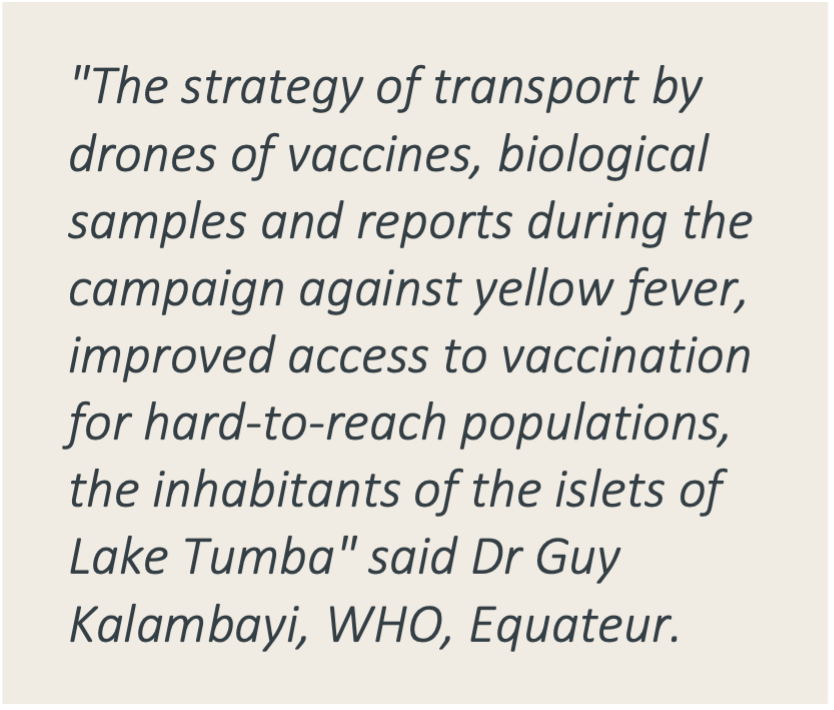 Equateur province, in the northeastern part of DRC is home to a two-way delivery network using Swoop Aero drone technology to serve remote and hard-to-reach health facilities and communities. The Provincial Ministry of Health, with the technical assistance of VillageReach and financial support from donors coming together, including GAVI, the Vaccine Alliance, and the Bill & Melinda Gates Foundation, established operations to address the medical delivery needs given the challenging terrain in the region.
Equateur province, in the northeastern part of DRC is home to a two-way delivery network using Swoop Aero drone technology to serve remote and hard-to-reach health facilities and communities. The Provincial Ministry of Health, with the technical assistance of VillageReach and financial support from donors coming together, including GAVI, the Vaccine Alliance, and the Bill & Melinda Gates Foundation, established operations to address the medical delivery needs given the challenging terrain in the region.
Using a drone delivery network, the provincial health authorities have been distributing both routine and on-demand vaccines and other immunization products monthly for children and women in 35 hard-to-reach health areas, via 20 drone landing sites. Because the drones can land almost anywhere, the drones return with a broad range of products, including yellow fever and COVID-19 laboratory samples.
Other deliveries have included medical reports, and at times on-demand deliveries of personal protective equipment (PPE) in support of the COVID-19 response, as well as vaccines, medicines and contraceptives. Now the results are in and the delivery network is delivering successful outcomes. In the last nine months, more than 15,000 children and 5,500 pregnant women who live in the most hard-to-reach locations have received immunization services because of the introduction of drones.
Given this success, it is no wonder that the provincial government is once more turning to the drone technology to help meet its objective of reaching more than three million people aged between nine months and 60 years of age during the 10-day yellow fever preventive campaign in Equateur.
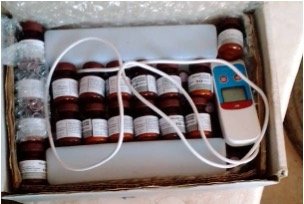 Important reports help keep track of the vaccine campaign
Important reports help keep track of the vaccine campaign
Dr. Nicole Lubanda, the lead representative for yellow fever and measles from the EPI, traveled to the Bikoro health district to serve as the national supervisor for the yellow fever mass vaccination campaign.
She learned of the support that the drones had provided to the district with routine vaccine deliveries. When she reached the site, one of the drones was arriving at the district-landing site from a trip to Maanga, which is one of three health catchment areas benefiting from drone deliveries of yellow fever vaccines. It is a village only accessible through a lake and situated 100 km from the Bikoro health district office.
She was amazed to open the storage compartment of the drone that just arrived and said “[…] the drone helps us to ship both vaccines and other products as well as daily reports so that we can keep track of the [progress of the campaign]. [Within] about 10 to 20 minutes, we sent 5 to 10 frozen accumulators or vaccines and this allows us to supply hard-to-reach areas in record time.”

Trips reduced from two days to 25 minutes
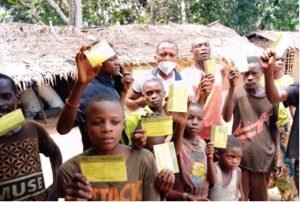 Ipombo is a village in the Lolanga Bobanga health district located 37 kilometers from Mbandaka, the capital of Equateur. However, what seems like a short distance requires a two and half hour trip by canoe down the Congo River followed by an additional half an hour travel by road. In previous campaigns, David Moponda, the head nurse of the Ipombo health facility, would have had to load his supplies of syringes, vaccines and diluents, as well as vaccination cards onto a canoe to make the journey. But for this campaign he didn’t worry as drones had transported them.
Ipombo is a village in the Lolanga Bobanga health district located 37 kilometers from Mbandaka, the capital of Equateur. However, what seems like a short distance requires a two and half hour trip by canoe down the Congo River followed by an additional half an hour travel by road. In previous campaigns, David Moponda, the head nurse of the Ipombo health facility, would have had to load his supplies of syringes, vaccines and diluents, as well as vaccination cards onto a canoe to make the journey. But for this campaign he didn’t worry as drones had transported them.
“This year has been different with the support from Drones for Health. More than 9,900 doses of yellow fever vaccines and diluents would be needed in Ipombo to vaccinate the targeted population between the ages of nine months and 60 years of age,” said David Moponda. “Within a four-day period, and only 25 minutes for each trip, the drones had already delivered 4,200 doses of the vaccine.”
Operations had to be suspended since the refrigerator of the health facility was already at full capacity. However, once space is freed up, flights will take off again.
Yellow fever vaccine campaign transformation
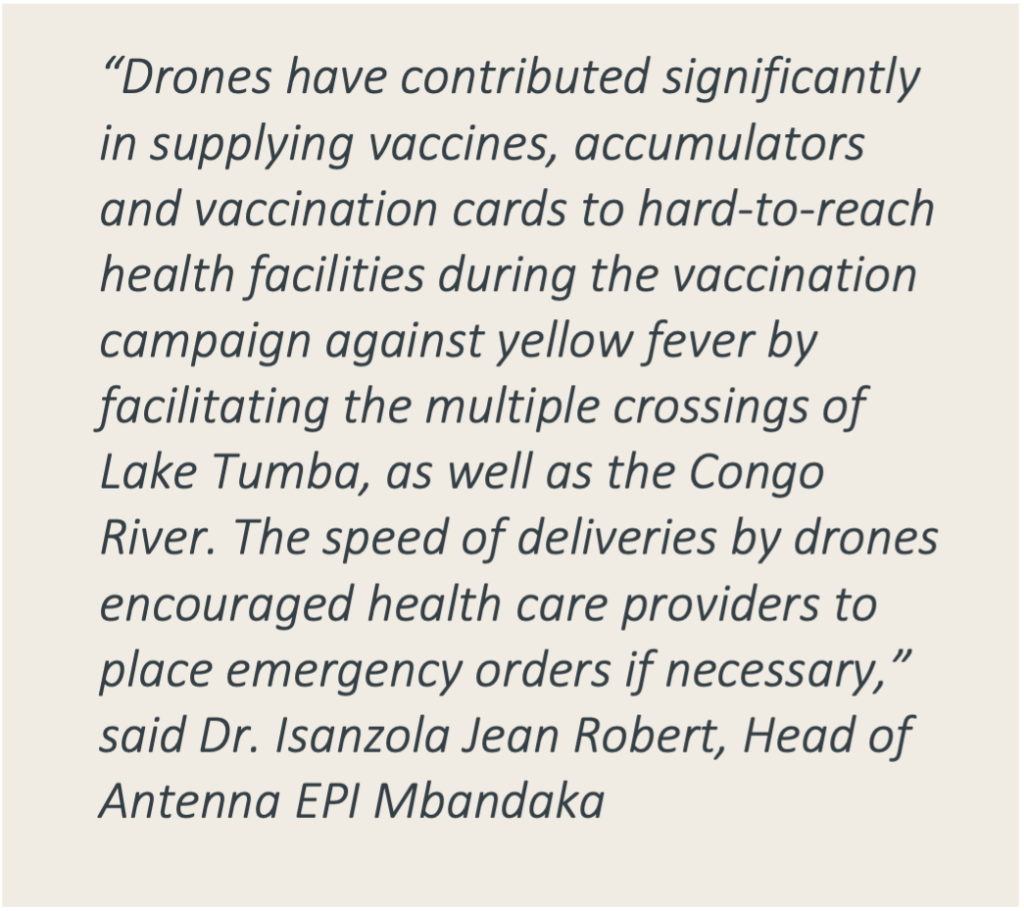 From a technical perspective, the drones transformed the vaccine campaign in three key ways:
From a technical perspective, the drones transformed the vaccine campaign in three key ways:
1) The drones enabled to leapfrog the lack of functional cold chain where the campaign was being conducted. Drones allowed for just-in-time delivery of yellow fever vaccines to the campaign team as the campaign progressed in the region, eliminating the need for cold-chain equipment.
2) The drones allowed for rapid-response to unexpected needs encountered by the campaign team. This allowed on-demand resupply of products, like vaccination cards.
3) Epidemiologic surveillance activities were increased and drones allowed for quick transport of samples from health facilities to provincial-level laboratories for processing.
Overall, the drones increased the reach, effectiveness and responsiveness of the yellow fever vaccine campaign.
As the campaign nears its end, it is clear that creative solutions come from using what is already available, but in new ways – and leveraging a drone network used for routine delivery for a mass vaccine campaign has just expanded the value of drone technology for the health system in Equateur, DRC.
Read more from Olivier Defawe in an earlier DRONELIFE Op-Ed: COVID-19 is Here: Now, Where are the Drones?
 Olivier Defawe, Director Health Systems at VillageReach, leads the design and implementation of a broad portfolio of health innovations to improve health care delivery at the last mile. Defawe has been the Drones for Health program lead since its inception in 2015. He oversees the implementation drone delivery programs in Democratic of Congo (DRC), Malawi, Mozambique, Central African Republic and the Dominican Republic. He is also the founder of the UAV for payload delivery working group (UPDWG) focused on the advancement and application of drones for public health and supply chain improvement through the coordination of evidence generation and experience among partners and stakeholders. Defawe holds a PhD in Biomedical sciences.
Olivier Defawe, Director Health Systems at VillageReach, leads the design and implementation of a broad portfolio of health innovations to improve health care delivery at the last mile. Defawe has been the Drones for Health program lead since its inception in 2015. He oversees the implementation drone delivery programs in Democratic of Congo (DRC), Malawi, Mozambique, Central African Republic and the Dominican Republic. He is also the founder of the UAV for payload delivery working group (UPDWG) focused on the advancement and application of drones for public health and supply chain improvement through the coordination of evidence generation and experience among partners and stakeholders. Defawe holds a PhD in Biomedical sciences.
https://dronelife.com/2022/01/09/village-reach-drones-are-a-hero-in-yellow-fever-immunization-campaign/
 Unmanned Aerial Vehicle The latest drone news
Unmanned Aerial Vehicle The latest drone news



